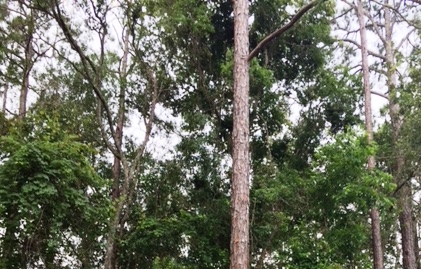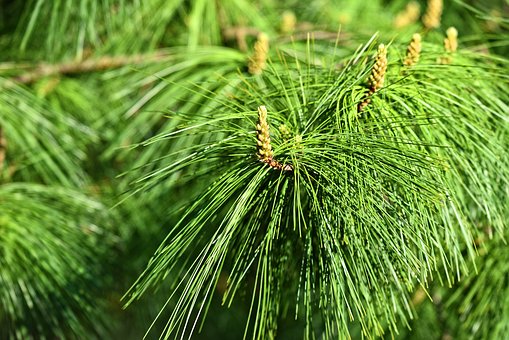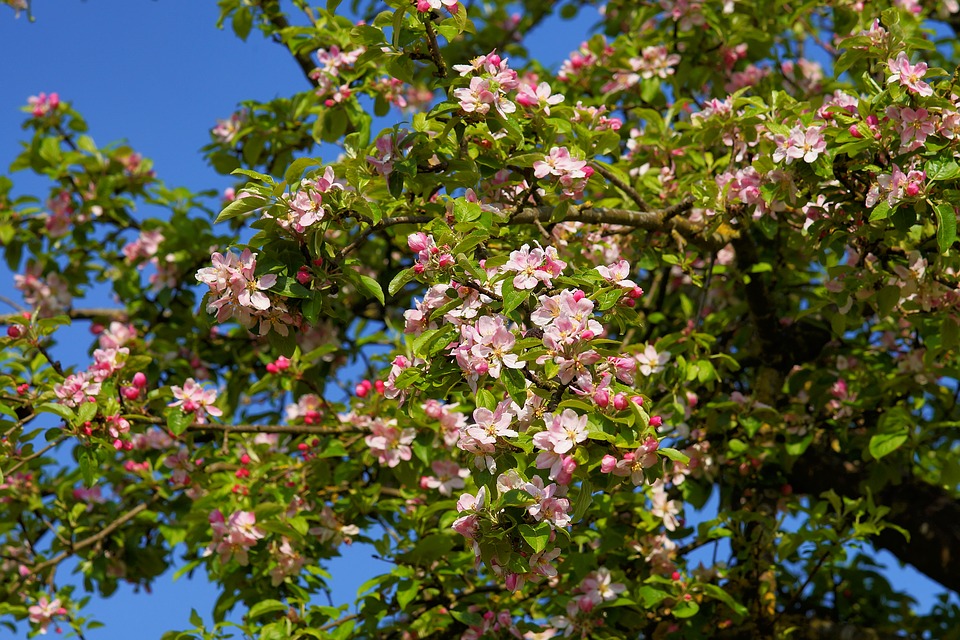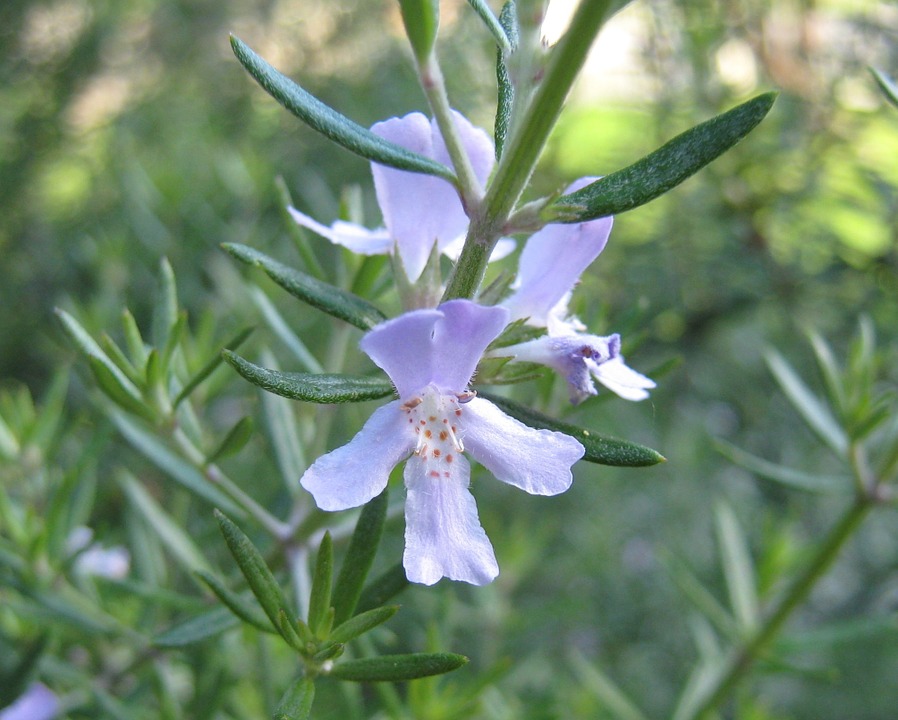Discover Florida Nature
It's time to explore the natural Florida


|
|
|
|
|
Pine Trees: The state of Florida has two types of pine
tree, the scrub pine and the slash pine. Sand
Pine (Pinus clausa)- Sand pine is also called scrub pine. The natural
range of sand pine is limited to parts of Florida and Alabama, where it
grows well in the acidic soils that developed from ancient Pleistocene
sand deposits. Sand pine has an extensive, fibrous root system that
helps to stabilize soils and prevent erosion. The trees are susceptible
to insect damage, especially from bark beetles and sand pine sawflies,
and may also suffer from mushroom root rot. Sand pine is most often seen
in dense, even-aged stands that require regular fire to open and release
the cones. The Big Scrub region of central Florida has the largest stand
of sand pine, encompassing 250,000 acres in the
Ocala National Forest. Sand
Pine (Pinus clausa)- Sand pine is also called scrub pine. The natural
range of sand pine is limited to parts of Florida and Alabama, where it
grows well in the acidic soils that developed from ancient Pleistocene
sand deposits. Sand pine has an extensive, fibrous root system that
helps to stabilize soils and prevent erosion. The trees are susceptible
to insect damage, especially from bark beetles and sand pine sawflies,
and may also suffer from mushroom root rot. Sand pine is most often seen
in dense, even-aged stands that require regular fire to open and release
the cones. The Big Scrub region of central Florida has the largest stand
of sand pine, encompassing 250,000 acres in the
Ocala National Forest. Slash
Pine (Pinus elliottii)- Because of its rapid growth rate, slash
pine is a valuable southern pine for reforestation projects and timber
plantations throughout the southeastern United States. Slash pine is
naturally found in wet flatwoods, swampy areas, and shallow pond edges.
It can occur in the low sandy soils that are poor in nutrients. The pine
seeds of slash pine are an excellent food source for gray and fox
squirrels and wild turkey. flatwoods slash pines have been planted,
grown, and harvested over millions of acres. It takes 30 years to become
saw timber size (greater than 9" in diameter). Slash pine is an
excellent forestry investment. A good site can produce a well-stocked
stand of about two cords of wood per acre per year. Slash
Pine (Pinus elliottii)- Because of its rapid growth rate, slash
pine is a valuable southern pine for reforestation projects and timber
plantations throughout the southeastern United States. Slash pine is
naturally found in wet flatwoods, swampy areas, and shallow pond edges.
It can occur in the low sandy soils that are poor in nutrients. The pine
seeds of slash pine are an excellent food source for gray and fox
squirrels and wild turkey. flatwoods slash pines have been planted,
grown, and harvested over millions of acres. It takes 30 years to become
saw timber size (greater than 9" in diameter). Slash pine is an
excellent forestry investment. A good site can produce a well-stocked
stand of about two cords of wood per acre per year.![By Photo by David J. Stang [CC BY-SA 4.0 (https://creativecommons.org/licenses/by-sa/4.0)], via Wikimedia Commons](cacia%20pinetorum.jpeg) Pineland
Acacia (Acacia pinetorum)- The pineland acacia is a perennial
shrub. It is a Medium shrub with long zigzag branches armed with stout
pairs of stipular spines. Leaves thin and feathery, light green. It has
spiny branches and a green to grayish-green bipinnate leaf. The pineland
acacia is an accent flowering shrub in sunny locations. Also an
effective and colorful addition to spiny barrier plantings. The typical
height for this shrub is 3-6 feet and it rarely grows to 10 feet or
more. The pineland acacia is as broad as it is tall or broader. Found in
Florida's Pine rocklands, marl prairies, coastal berms and shell mounds,
the Pineland acacia is found in Monroe, Miami-Dade, Collier and Lee
counties. Pineland
Acacia (Acacia pinetorum)- The pineland acacia is a perennial
shrub. It is a Medium shrub with long zigzag branches armed with stout
pairs of stipular spines. Leaves thin and feathery, light green. It has
spiny branches and a green to grayish-green bipinnate leaf. The pineland
acacia is an accent flowering shrub in sunny locations. Also an
effective and colorful addition to spiny barrier plantings. The typical
height for this shrub is 3-6 feet and it rarely grows to 10 feet or
more. The pineland acacia is as broad as it is tall or broader. Found in
Florida's Pine rocklands, marl prairies, coastal berms and shell mounds,
the Pineland acacia is found in Monroe, Miami-Dade, Collier and Lee
counties. Pond
Apple (Annona glabra)- A kind of black sheep of the Annonaceae
family, the pond apple is found wild throughout much of the American
tropics. The flesh is usually palatable, but often pales in comparison
to the more illustrious members of its family, the cherimoya, sugar
apple, soursop and atemoya. Some trees do produce nice fruits and the
species has its admirers. A medium-sized tree to 40-50 feet, pond
apple's can stand immense flooding and spend weeks at a time with their
roots under water. The pond apple is very useful as a rootstock for
other Annona species. Native throughout the West Indies and north to
Florida, the pond apple is a predominant species in the Everglades. Pond
Apple (Annona glabra)- A kind of black sheep of the Annonaceae
family, the pond apple is found wild throughout much of the American
tropics. The flesh is usually palatable, but often pales in comparison
to the more illustrious members of its family, the cherimoya, sugar
apple, soursop and atemoya. Some trees do produce nice fruits and the
species has its admirers. A medium-sized tree to 40-50 feet, pond
apple's can stand immense flooding and spend weeks at a time with their
roots under water. The pond apple is very useful as a rootstock for
other Annona species. Native throughout the West Indies and north to
Florida, the pond apple is a predominant species in the Everglades.![By Joshua Tree National Park [CC BY 2.0 (https://creativecommons.org/licenses/by/2.0) or Public domain], via Wikimedia Commons](Queens-Delight.png) Queensdelight
(Stillingia sylvatica L) -Queen's delight is a perennial herb growing to
4 feet tall. Leathery, elliptical alternate leaves, about 1-3 inches
long, are finely toothed and nearly stalkless. Yellow flowers of queen's
delight (March-August or all year in warm climates) are petalless and
occur in dense terminal spikes, with the male blossoms along the upper
part of the spike and the female blossoms along the lower part.
Queen's-delight was once a popular home medicine with settlers in the
region. They claimed that its root had many virtues. Native to the
United States, queen's-delight grows from Virginia south to Florida and
Texas, and west to southeastern Colorado. Queensdelight
(Stillingia sylvatica L) -Queen's delight is a perennial herb growing to
4 feet tall. Leathery, elliptical alternate leaves, about 1-3 inches
long, are finely toothed and nearly stalkless. Yellow flowers of queen's
delight (March-August or all year in warm climates) are petalless and
occur in dense terminal spikes, with the male blossoms along the upper
part of the spike and the female blossoms along the lower part.
Queen's-delight was once a popular home medicine with settlers in the
region. They claimed that its root had many virtues. Native to the
United States, queen's-delight grows from Virginia south to Florida and
Texas, and west to southeastern Colorado. Red
Mulberry (Morus rubra) -Red mulberry extends from Massachusetts
and southern Vermont west through the southern half of New York to
extreme southern Ontario, southern Michigan, central Wisconsin and
southeastern Minnesota; south to Iowa, southeastern Nebraska, central
Kansas, western Oklahoma and central Texas; and east to southern
Florida. It is also found in Bermuda. Red mulberry grows on a variety of
moist soils. Red mulberry is dioecious but can be monoecious, with male
and female flowers on different branches of the same plants. Both male
and female flowers are stalked axillary pendulous catkins and appear in
April and May. The blackberry-like fruit reaches full development from
June to August. Each fruit is composed of many small drupelets which
develop from separate female flowers ripening together. Red
Mulberry (Morus rubra) -Red mulberry extends from Massachusetts
and southern Vermont west through the southern half of New York to
extreme southern Ontario, southern Michigan, central Wisconsin and
southeastern Minnesota; south to Iowa, southeastern Nebraska, central
Kansas, western Oklahoma and central Texas; and east to southern
Florida. It is also found in Bermuda. Red mulberry grows on a variety of
moist soils. Red mulberry is dioecious but can be monoecious, with male
and female flowers on different branches of the same plants. Both male
and female flowers are stalked axillary pendulous catkins and appear in
April and May. The blackberry-like fruit reaches full development from
June to August. Each fruit is composed of many small drupelets which
develop from separate female flowers ripening together. (Florida)
Rosemary (Ceratiola ericoides)- Rosemary, also called Florida
rosemary or sandhill rosemary, is a native shrub distinguished by its
rounded form. The shrub gives off a chemical substance that delays the
germination of its seeds until after the parent plant has died, thus
ensuring a full-sun location for the bush to grow in and reducing
competition for water and nutrients. The distinctly rounded shape of the
shrub helps to protect it from wind and blowing sand while the revolute
leaves aid in the retention of water and allow the plant to survive in
harsh, dry (xeric) habitats or drought conditions. Rosemary balds are
areas with excessively deep, loose sand and harsh conditions, where
rosemary is the only surviving shrub. While it may be locally abundant,
it is considered a threatened species in some parts of its range.
Rosemary is easily destroyed by fire. Rosemary is found in coastal
plains from southeastern South Carolina to southern Mississippi and
peninsular Florida. (Florida)
Rosemary (Ceratiola ericoides)- Rosemary, also called Florida
rosemary or sandhill rosemary, is a native shrub distinguished by its
rounded form. The shrub gives off a chemical substance that delays the
germination of its seeds until after the parent plant has died, thus
ensuring a full-sun location for the bush to grow in and reducing
competition for water and nutrients. The distinctly rounded shape of the
shrub helps to protect it from wind and blowing sand while the revolute
leaves aid in the retention of water and allow the plant to survive in
harsh, dry (xeric) habitats or drought conditions. Rosemary balds are
areas with excessively deep, loose sand and harsh conditions, where
rosemary is the only surviving shrub. While it may be locally abundant,
it is considered a threatened species in some parts of its range.
Rosemary is easily destroyed by fire. Rosemary is found in coastal
plains from southeastern South Carolina to southern Mississippi and
peninsular Florida.
|
|
|
Advertise | Privacy Statement | Dog Encyclopedia | Video |Contact | Alaska Nature |
|